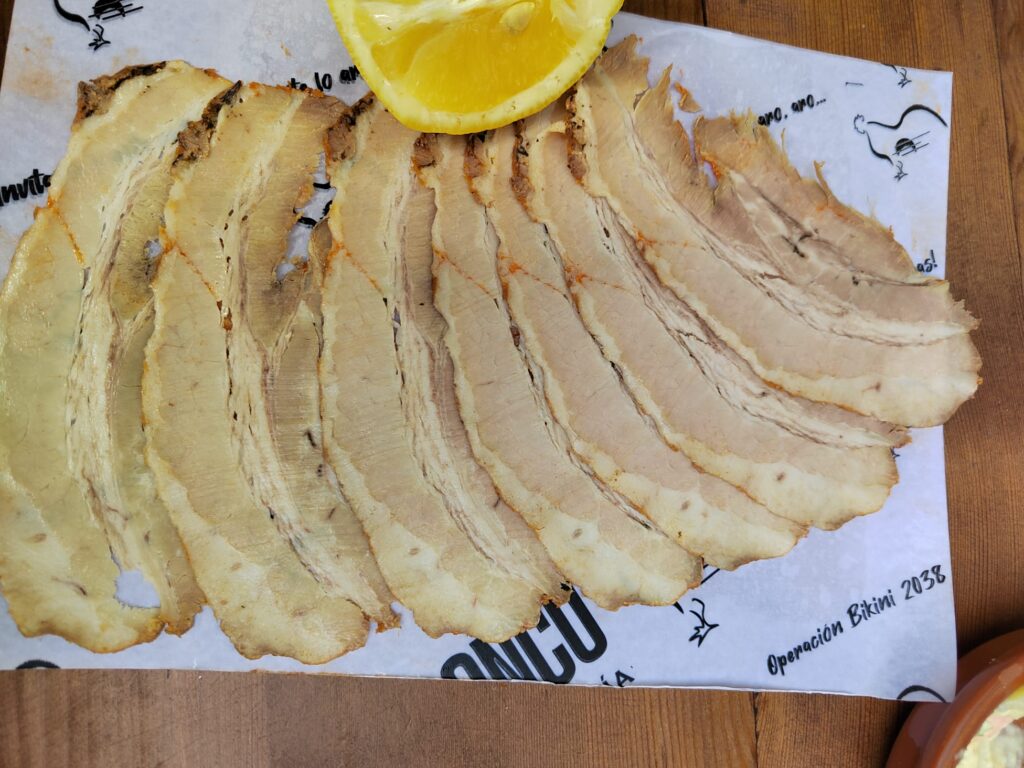The etymology of Chicharrón is uncertain, although many of us would like it to come from “chicha” (a type of drink) and “ron” (rum), the most probable origin of the word “chicharrón” (fried pork rind) itself is the onomatopoeia “chich-” (the sound made by the chicharrón when fried). From there we also have the words “achicharrar” (to fry until burnt) and “chicharro” (another way to refer to chicharrón). BUT BEWARE! Not all chicharrones are fried. In our “abacería,” we have the Cadiz-style or Special Chicharrones that are marinated instead of fried and are delicious.
What are Chicharrones?
Chicharrones is a trendy tapa that is spreading throughout Spain, and the “special” type is especially popular. It consists of pieces of pork belly, an area of the pig that alternates layers of meat with bacon, although pieces of jowl are also used. This gives the pieces a special juiciness. Butchers call it “pear belly” because of its shape, which resembles a pear. The pieces are fried in pork lard, and then, to consume them, they are typically sliced thinly.
According to history, chicharrones emerged as a way to use up the leftovers from pig slaughters, a practice that dates back to Roman times. The Romans already knew how to make chicharrones, but it was in Andalusia where the technique was perfected and the recipe that we enjoy today in taverns, inns, and “abacerías” was created.
Cadiz-style Chicharrones: a delicacy to enjoy at El Gallo Ronco
Cadiz-style Chicharrones are a typical sausage from Andalusia made from pork skirt with an unbeatable texture and flavor that makes them irresistible to many. But what is the origin of this delicious product?
In Cadiz, chicharrones are particularly popular, and their preparation remains an art that is passed down from generation to generation, with special mention to the chicharrones of Chiclana, one of the four Cadiz schools that make this delicacy. The typical seasoning, in addition to cooking in pork lard, includes oregano, garlic, and bay leaf, although the people of Chiclana omit the latter ingredient.
Cadiz-style Chicharrones are a delight for the palate and an example of how popular wisdom and culinary tradition come together to create unique and flavorful products. Moreover, their popularity has transcended the borders of Andalusia, becoming a sausage that is enjoyed throughout the country. The variant of fried or dried chicharrón is less popular because its transportation and distribution make it impossible for them to arrive crispy, which is the main value of this other recipe.
In conclusion, Cadiz-style Chicharrones are yet another example of Spain’s culinary richness and a product that deserves to be enjoyed and valued for its taste and tradition at our El Gallo Ronco restaurants in the heart of Malaga.
At El Gallo Ronco, we love gastronomy and flamenco, so if you want to expand your culinary experience, don’t hesitate to check out our Prix Fixe Menus, and don’t miss the chance to pair your experience with a high-level flamenco show just a few centimeters away from the stage.





